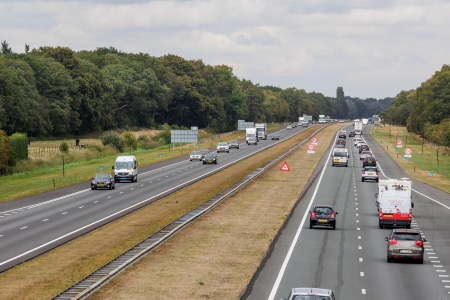Infrastructure
Besides the design of the roadsides themselves, other infrastructural measures can be taken to help prevent run-off-road crashes.
In road design, it is important to avoid unexpectedly tight curves [23]. See the question What are the causes of run-off-road crashes? Widening excessively tight curves can substantially reduce the risk of a run-off-road crash. When the curve itself cannot be adjusted, it is important to alert drivers to the tight curve with appropriate marker posts [34], so that they can adjust their driving speed accordingly [35]. Crash studies do not say how many crashes can be prevented by marking curves.
According to international research [32], a wider cross section may also contribute to a reduction in the number of (run-off-road) crashes. This concerns the entire cross section, i.e. both a wider carriageway, lane and narrow paved shoulder, and wider driving direction separation than is common in the Netherlands. Indeed, compared to other European roads, Dutch roads are relatively narrow.
With vibration and sound, Rumble strips (transverse rumble strips) in the edge markings of medians or roadsides may alert drivers that they are in danger of leaving the lane, thus preventing (run-off-road) crashes [36] [37] [38] [39]. In the Netherlands, rumble strips are hardly applied because of noise pollution affecting the environment.
Vehicle systems
Vehicle safety systems can also help prevent crashes (see SWOV fact sheets Safe passenger cars and Intelligent transport- and advanced driver assistance systems (ITS and ADAS)).
Electronic stability control (ESC)
ESC (in combination with ABS) helps maintain vehicle stability and prevent skidding. According to international research [40] [41]. the system has a strong reducing effect on crashes. ESC has been mandatory in all new cars sold since 2014; it is estimated that about two-thirds of vehicles now have ESC [42].
Systems that monitor and/or correct the lateral position
Systems such as Lane Keeping Assist (LKA), Lane Departure Warning (LDW) and Lane Centering Assist (LCA) can warn and possibly intervene on their own if drivers gradually leave the lane and enter the roadside, for example due to distraction or fatigue [2] [43]. However, only little is known about the effectiveness of these systems in preventing (roadside) crashes and about their acceptance and use [43] [44] [45]. However, it is estimated that LDW can help prevent 10%-21% of crashes and LKA 20%-30% of crashes (including run-off-road crashes) due to gradually changing a vehicle’s direction [46].
Driver monitoring systems
Driver monitoring systems monitor whether the driver is still focused on the driving task. These types of systems monitor the driver for signals of fatigue and distraction, such as changes in driving style, especially steering behaviour [47], or the amount of time the driver's eyes are away from the road [48]. For signals of fatigue or distraction, the system can alert the driver with sound and/or haptic feedback. It is not yet known how effective these systems are in preventing crashes [47] [48].
New European motor vehicle regulations require both LKA and driver monitoring systems to be present in new vehicles from 2022 onwards (see the European Commission website). Incidentally, drivers are not obliged to turn on the systems.
Other measures
Finally, measures aimed at preventing unsafe behaviour that contributes to the occurrence or serious outcome of run-off-road crashes (see the section ‘human factors’ under the question What are the causes of run-off-road crashes?) may also help prevent run-off-road crashes. More specifically, these could include:
- Measures to combat fatigue of professional drivers, such as legislation on driving times and rest periods, and attention to the topic among employers (see SWOV fact sheet Fatigue).
- Enforcement, supported by publicity campaigns, on speed, use of alcohol and drugs, seatbelt use and phone use (see SWOV fact sheet Traffic enforcement).
